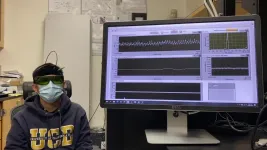(Press-News.org) If you did not catch the flu this year -- and there is an overwhelming chance that you did not -- you have COVID-19 to thank.
It's a small consolation, given the enormously disruptive scope of the pandemic. But it's the focus of a new paper published in the journal Frontiers in Public Health by two Concordia researchers and their colleagues that studies the 2020 influenza figures from Canada, the United States, Australia and Brazil. The authors show there is a clear relationship between the implementation of COVID-mitigation measures such as hand-washing, masking and social distancing and the spread of the annual flu.
They write that these preventive measures all but eliminated the flu in countries where it can kill tens of thousands of people a year, even as cases of COVID-19 soared.
"With the introduction of COVID-19 mitigation measures, we saw a steep decline in influenza cases in the northern hemisphere," says Jovana Stojanovic, a postdoctoral fellow in the Department of Health, Kinesiology and Applied Physiology and the lead author of the paper.
"Then we also observed that as COVID-19 cases went up and down in different ways, influenza was basically annulled across both the north and south hemispheres. That speaks volumes about how contagious COVID-19 is compared to influenza."
Simon Bacon, a professor of health, kinesiology and applied physiology, co-authored the paper, along with Vincent Boucher and Kim Lavoie at UQAM as well as Jacqueline Boyle and Joanne Enticott of Monash University in Australia.
No peaks, all valleys
The researchers initially had two objectives. The first involved using data from FluNet, the World Health Organization's influenza virological surveillance tool. They wanted to see how the epidemiological pattern of the 2019-20 influenza tracked onto the evolution of the COVID-19 pandemic after the introduction of public mitigation measures were introduced in Canada, the United States, Australia and Brazil.
The second was to combat the misleading statements and disinformation being circulated worldwide that COVID-19 was similar to influenza. Their graphs below clearly show the stark differences in transmissibility between the influenza and novel coronavirus.
"In the northern hemisphere, we initially had overlapping flu and COVID-19 cases," Bacon says. "When we introduced basic measures like hand-washing, social distancing and wearing masks, the flu was almost totally obliterated while COVID kept going."
The researchers note that the first two graphs, looking at Canada and the United States, show significant reduction of influenza cases compared with the averages of the four previous years after mitigation efforts were introduced (indicated by the solid black line). Flu season, which usually runs from October to May, effectively ended a month earlier in Canada and almost two months earlier in the United States. Cases remained close to nil at the start of the 2020 flu season in both countries, which roughly coincided with the second COVID-19 wave.
The next set of graphs, showing figures from Brazil and Australia, reveal similar figures. Flu season in the southern hemisphere lasts from May to November but in these cases, there was no traditional mid-year spike for flu, though COVID-19 was nearing its second-wave high. Flu cases remained near zero through the end of the year.
Easy steps
These findings offer lessons for public health authorities as we eye a post-COVID future, Bacon explains.
"We know the flu is particularly problematic for older individuals and those with respiratory conditions and so on," he says. "When we interact with people in those high-risk brackets, we should maintain some measures like handwashing, mask-wearing and social distancing. We're used to them now, so maintaining them moving forward is probably a good idea."
INFORMATION:
Read the cited paper: "COVID-19 Is Not the Flu: Four Graphs From Four Countries."
The quest to create safer, more successful pregnancies is one of the top goals of modern science. While pregnancy is better understood today than ever before, with improvements in technology helping to lower the risk of negative outcomes, there is much researchers still don't know about a vital part of the pregnancy process: uterine fluid.
Secreted by glands in the uterus during pregnancy, uterine fluid is believed to play an important role in supporting a developing embryo by sending information from the uterus to the embryo, along with a host ...
In 2020, stores sold out of garden seed, coops and rabbit cages. Now, we have an idea how much protein people can grow in their backyards.
The 2020 meat shortages led many to wonder what to eat for protein when supply chains are disrupted. Some people turned to gathering eggs, raising animals and growing their own food. A team from Michigan Technological University and the University of Alaska Fairbanks found that the work is well worth it. In a new study published in Sustainability, the researchers looked at how a typical household with a typical backyard can raise chickens, rabbits or soybeans to meet its protein needs.
People eat a lot of protein in the U.S. and the average person needs 51 grams of ...
MINNEAPOLIS/ST.PAUL (05/12/2021) -- In a study recently published in END ...
DURHAM, N.H.-- A national report from the University of New Hampshire shows close to one and a half million children each year visit a doctor, emergency room or medical facility as a result of an assault, abuse, crime or other form of violence. This is four times higher than previous estimates based only on data from U.S. emergency rooms for violence-related treatment.
In their END ...
A portable, rapid testing platform can detect gonorrhea infections in patient samples in under 15 minutes, far faster than standard-of-care tests that can take hours or days. The platform accurately detected infections and determined resistance to a common antibiotic in 217 patient samples from sexual health clinics in Baltimore and Uganda. The technology's speed and low cost could empower quicker and more affordable gonorrhea testing in low-resource regions, as well as help combat the spread of drug-resistant strains. Rates of gonorrhea and other sexually transmitted ...
A new, noninvasive method for measuring brain blood flow with light has been developed by biomedical engineers and neurologists at the University of California, Davis, and used to detect brain activation. The new method, functional interferometric diffusing wave spectroscopy, or fiDWS, promises to be cheaper than existing technology and could be used for assessing brain injuries, or in neuroscience research. The work is published May 12 in Science Advances.
"Now we can assess how well the brain regulates blood flow, and even detect brain activation noninvasively in adult humans, using principles similar to functional ...
MISSOULA - Only an anthropologist would treasure millennia-old human feces found in dry caves.
Just ask Dr. Meradeth Snow, a University of Montana researcher and co-chair of UM's Department of Anthropology. She is part of an international team, led by the Harvard Medical School-affiliated Joslin Diabetes Center, that used human "paleofeces" to discover that ancient people had far different microorganisms living in their guts than we do in modern times.
Snow said studying the gut microbes found in the ancient fecal material may offer clues to combat diseases like diabetes that afflict people living in today's industrialized societies.
"We ...
Researchers used genetic engineering tools to create a virus that can enter specific neurons and insert into the prefrontal cortex a new genetic code that induces the production of modified proteins. In tests with mice, the alteration of these proteins was sufficient to modify brain activity, indicating a potential biomarker for the diagnosis of psychiatric disorders such as schizophrenia and autism.
Sometimes referred to as the "executive brain", the prefrontal cortex is the region that governs higher-level cognitive functions and decision making. Studies of tissue from this brain region in patients with schizophrenia have detected alterations in two proteins: BDNF (brain-derived neurotrophic factor) and trkB (tyrosine receptor kinase B).
The relationship ...
A new study by the University of Georgia revealed that more college students change majors within the STEM pipeline than leave the career path of science, technology, engineering and mathematics altogether.
Funded by a National Institutes of Health grant and a National Science Foundation Postdoctoral Fellowship and done in collaboration with the University of Wisconsin, the study examined interviews, surveys and institutional data from 1,193 students at a U.S. midwestern university for more than six years to observe a single area of the STEM pipeline: biomedical fields of study.
Out of 921 students ...
UCLA life scientists have identified six "words" that specific immune cells use to call up immune defense genes -- an important step toward understanding the language the body uses to marshal responses to threats.
In addition, they discovered that the incorrect use of two of these words can activate the wrong genes, resulting in the autoimmune disease known as Sjögren's syndrome. The research, conducted in mice, END ...






